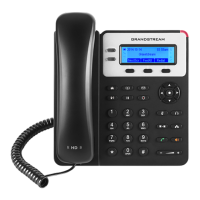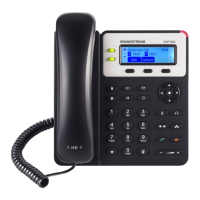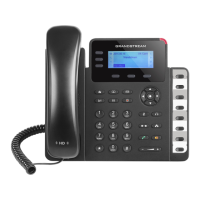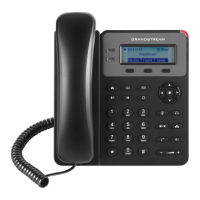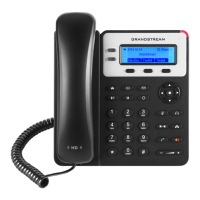GXP21XX Administration Guide
incoming INVITE. If it doesn't match the phone's SIP User ID, the call will be
rejected. The default setting is "No".
Accept Incoming SIP
from Proxy Only
When set to "Yes", the SIP address of the Request URL in the incoming SIP
message will be checked. If it doesn't match the SIP server address of the
account, the call will be rejected. The default setting is "No".
Authenticate Incoming
INVITE
If set to "Yes", the phone will challenge the incoming INVITE for
authentication with SIP 401 Unauthorized response. Default setting is "No".
Account x Audio Settings
Multiple vocoder types are supported on the phone, the vocoders in the list
is a higher preference. Users can configure vocoders in a preference list that
is included with the same preference order in SDP message.
Use First Matching
Vocoder in 200OK SDP
When it is set to "Yes", the device will use the first matching vocoder in the
received 200OK SDP as the codec. The default setting is "No".
Codec Negotiation
Priority
Configures the phone to use which codec sequence to negotiate as the
callee.
When set to “Caller”, the phone negotiates by SDP codec sequence from
received SIP Invite.
When set to “Callee”, the phone negotiates by audio codec sequence on the
phone. The default setting is “Callee”.
When option Hide Vocoder is set as Yes, the coded will be hidden from call
screen as bellow. The default setting is “No”.
Disable Multiple m line
in SDP
When it is set to “No”, the device will reply with multiple m lines; Otherwise,
it will reply 1 m line. The default setting is “No”.
Enable SRTP mode based on your selection from the drop-down menu. The
default setting is "Disabled".
Enable or disable the crypto life time when using SRTP. If users set to disable
this option, phone does not add the crypto life time to SRTP header. The
default setting is “Yes”.
Defines whether symmetric RTP is supported or not. Default setting is "No".
Controls the silence suppression/VAD feature of the audio codec G.729. If
set to "Yes", when silence is detected, a small quantity of VAD packets
(instead of audio packets) will be sent during the period of no talking. If set
to "No", this feature is disabled. The default setting is "No".
Selects either Fixed or Adaptive for jitter buffer type, based on network
conditions. The default setting is "Adaptive".
Selects jitter buffer length from 100ms to 800ms, based on network
conditions. The default setting is "300ms".
Configures the number of voice frames transmitted per packet. When
configuring this, it should be noted that the "ptime" value for the SDP will
change with different configurations here. This value is related to the codec

